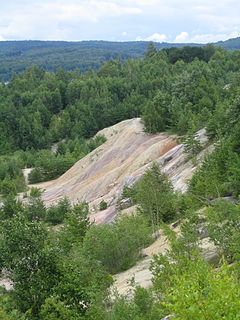| Kristianstad Basin | |
|---|---|
| Stratigraphic range: Late Cretaceous, Santonian – Early Maastrichtian, | |
 Kaolinbrottet, one of the quarries at Ivö Klack in the Kristianstad Basin | |
| Type | Structural basin, geological formation |
| Thickness | c. 250 m (820 ft) |
| Lithology | |
| Primary | Calcarenite, sandstone |
| Other | Conglomerates, flint, oyster banks, sand |
| Location | |
| Region | North-eastern Skåne |
| Country | |
| Type section | |
| Named for | Kristianstad, Kristianstad Municipality, Skåne County |
The Kristianstad Basin (Swedish: Kristianstadsbassängen)[1] is a Cretaceous-age structural basin and geological formation in northeastern Skåne, the southernmost province of Sweden. The basin extends from Hanöbukten, a bay in the Baltic Sea, in the east to the town of Hässleholm in the west and ends with the two horsts Linderödsåsen and Nävlingeåsen in the south. The basin's northern boundary is more diffuse and there are several outlying portions of Cretaceous-age sediments. During the Cretaceous, the region was a shallow subtropical to temperate inland sea and archipelago.
Though the sediments in the basin range in age from the Barremian to the earliest Maastrichtian, the only accessible strata are from the Late Cretaceous, ranging in age from the Early or early Middle Santonian to the earliest Maastrichtian. A majority of the fossil sites only expose strata of latest Early Campanian age (c. 80.5 million years ago). Fossils from these sites have been collected since the 18th century, but most of the excavations have taken place through commercial quarrying in the 20th century and paleontological expeditions in the 20th and 21st centuries.
The Early Campanian deposits of the Kristianstad Basin preserve fossils of a diverse array of organisms, including algae, brachiopods, bryozoans, molluscs (notably large numbers of bivalves and belemnites), sea urchins and fish (including a large amount of shark species). The Kristianstad Basin has also yielded fossils of several varieties of reptiles, including plesiosaurs, turtles and crocodylomorphs, as well as one of the most diverse mosasaur faunas in the world and some of the few non-avian dinosaurs known from Sweden.
- ^ Hajny, Cassandra (2014). "Ett mystiskt ryggradsdjursfossil från Åsen och dess koppling till den skånska, krittida ryggradsdjursfaunan". Examensarbeten I Geologi Vid Lunds Universitet (in Swedish).
